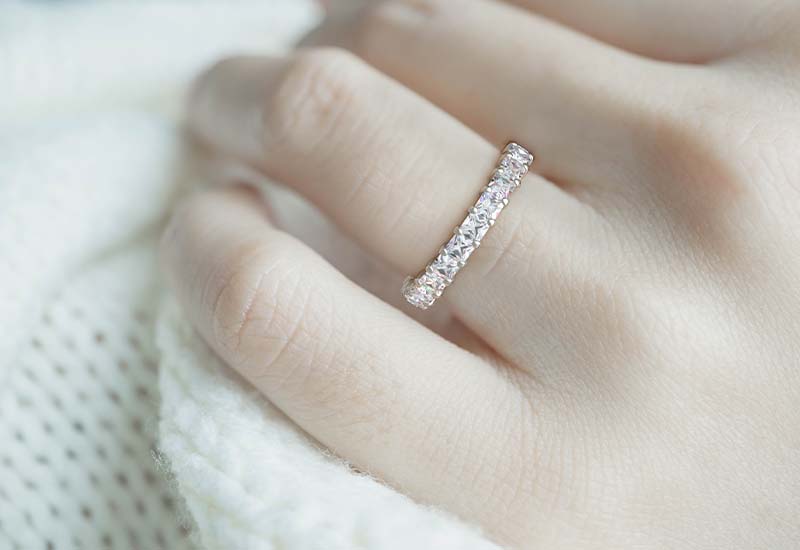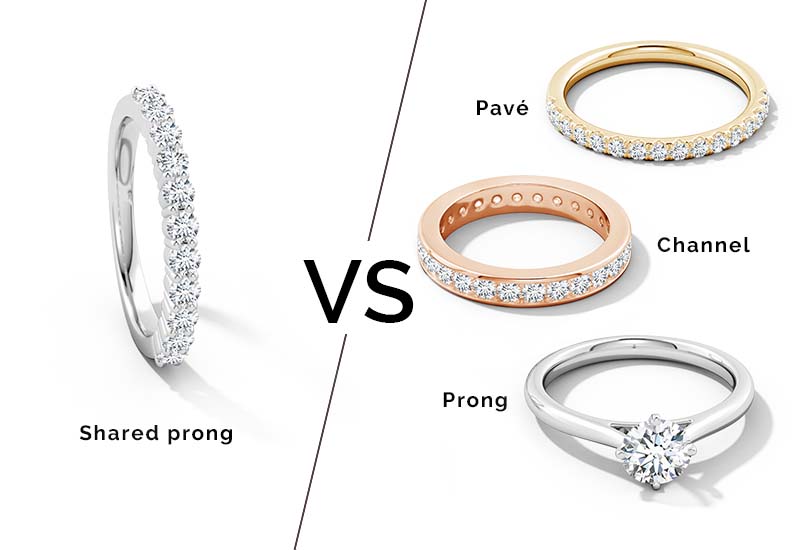Can you guess which is the most popular gemstone setting? Hint: It allows for maximum light exposure and ensures maximum sparkle! Yes, you got it right––it’s the PRONG setting. In this classic setting, the gemstone is held in place by four or more metal pins that act like claws.
Now, let’s say you want more than one gem on your ring without doing away with the brilliance offered by the prong setting? This is where the Shared Prong Setting comes into the picture!
Want To Know More About This Setting? Keep Reading…
What is a Shared Prong Setting?
In the jewellery world, the shared prong setting is often confused with pavé and channel settings. They do offer a similar appearance on a band or a shank but are completely different from one another. You’ll discover that in a bit, but before that, here’s what the shared prong setting does––it incorporates prongs that are shared by adjacent gemstones to create a line of sparkle, with minimum metal usage.
This setting is a popular choice for diamond and coloured gemstone eternity rings and wedding bands. Future brides, are you listening?

What We Love (and Don’t) About the Shared Prong Setting:
If you’re thinking about getting your next jewellery piece in a shared prong setting, here’s what you need to know.
Shared Prong Setting: Pros
- One of the biggest advantages of a shared prong setting is that it allows maximum light to reflect off the gems. This amplifies the overall brilliance of your ring. Bling, bling, bling… from every angle!
- Another plus point of the shared prong setting is that it elevates the gems and makes them appear larger than their original size. Now who doesn’t want that?
- If you know anything about prong-set jewellery, then you’d be aware of how easy it is to clean. This applies to shared prong-set jewels too.
Shared Prong Setting: Cons
- Prongs or claws can get caught in your clothes, hair, gloves and fuzzy woolens. This can happen when one or more prongs are either raised due to a poor setting or have thinned out due to wear and tear. You’ll need to take extra care when doing any hand-heavy activities that may cause damage to the prongs.
- As a shared prong setting uses lesser prongs, it causes more strain on each one of them. This may cause faster loosening of prongs.
- Settings with multiple gemstones are often difficult to repair. In case one stone falls out, you’ll need to find another of the same size that’ll fit in the existing prongs.
Pro tip: Inspect the condition of your jewellery regularly to avoid losing a stone. If you notice a raised or worn-out prong, or a rattling sound, make sure to get it fixed by a professional.
Shared Prong Setting vs Other Settings

Let the battle begin.
1. Shared Prong vs Pave
Shared prong and pave settings may look similar at a glance. But they are completely different. Pave setting involves small individual beads, called micro prongs, to hold ‘melee’ or tiny diamonds in place. On the other hand, the shared prong setting uses metal prongs (similar to classic prongs, but much smaller) to hold slightly larger stones together. While pave setting can be used to form intricate designs, the shared prong setting is employed to create simple, linear patterns on jewellery. However, the latter is a more secure setting.
2. Shared Prong vs Channel
The channel setting involves metal tracks that decrease the visibility of the gems. These metal walls also tend to make the jewellery look and feel bulky. With a shared prong setting, the coloured gems and diamonds receive maximum visibility as the prongs leave a lot of space for light to pass through. The downside? It is susceptible to snagging on loose threads, woolens and hair.
3. Shared Prong vs Classic Prong
Do they sound similar? Well, they are. The shared prong setting is indeed a variation of the classic prong setting with a slight difference. Classic prongs are used to set bigger gems in the centre of the jewellery. The ‘shared’ prongs are used to secure smaller stones, either on a shank of a ring or on an eternity band.
Bottom line:
If it’s a timeless ring design that you’ve set your heart on, the shared prong setting is just what you should opt for. Also, who could possibly resist the brilliance and shine it offers?!



























